Business Research Report: Cloud Computing Advantages & Disadvantages
VerifiedAdded on 2020/03/02
|15
|3641
|33
Report
AI Summary
This report provides a comprehensive analysis of cloud computing in a business context. It begins with an introduction highlighting the increasing importance of cloud technology for enhancing productivity and data management. The objectives of the study include understanding the key advantages and disadvantages of cloud computing, exploring various models and theories, and examining its future in business. The scope of the project emphasizes the need to understand how cloud computing functions and its impact on business operations. The research questions focus on the advantages and disadvantages of cloud computing, the existing literature, its impact on business management, and the gaps in the current research. The methodology section details the research philosophy (positivism) and approach (deductive), and the use of both qualitative and quantitative research methods. The report also discusses the research design, data collection methods, sampling, and the importance of data reliability and validity. The report concludes with a time schedule and references to support the findings. The report aims to provide a detailed overview of cloud computing's role in business, its benefits, and its limitations, making it a valuable resource for students and researchers on Desklib.
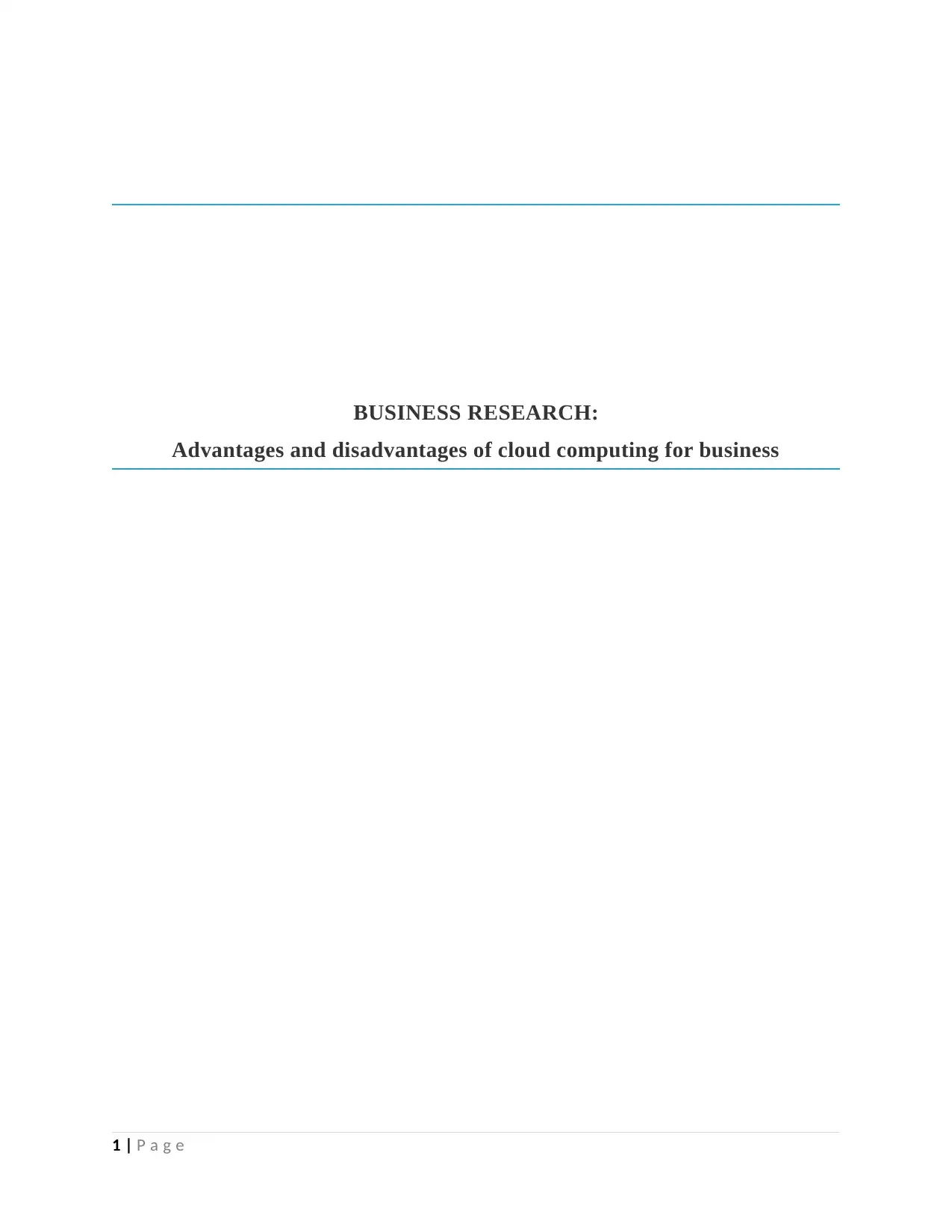
BUSINESS RESEARCH:
Advantages and disadvantages of cloud computing for business
1 | P a g e
Advantages and disadvantages of cloud computing for business
1 | P a g e
Paraphrase This Document
Need a fresh take? Get an instant paraphrase of this document with our AI Paraphraser
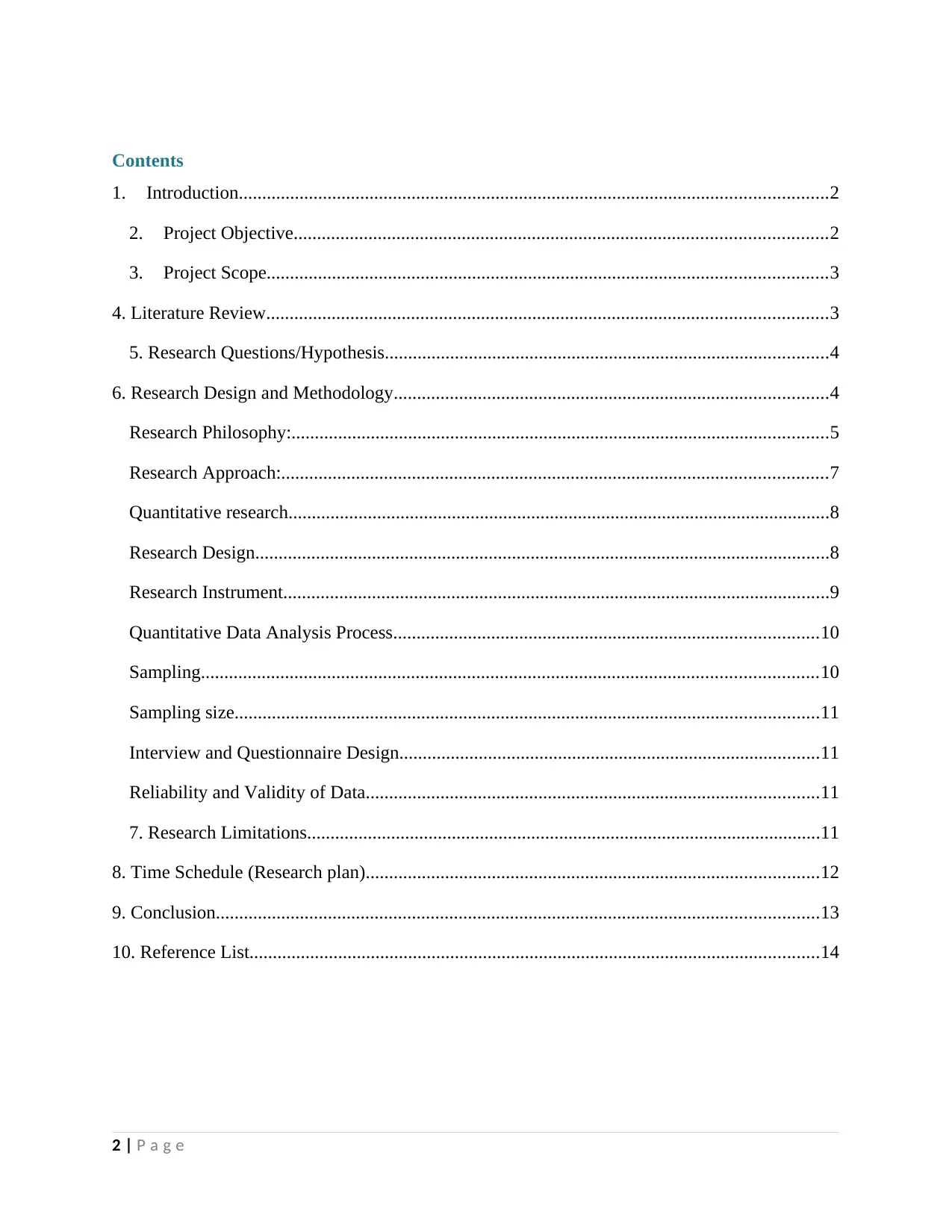
Contents
1. Introduction..............................................................................................................................2
2. Project Objective..................................................................................................................2
3. Project Scope........................................................................................................................3
4. Literature Review........................................................................................................................3
5. Research Questions/Hypothesis...............................................................................................4
6. Research Design and Methodology.............................................................................................4
Research Philosophy:...................................................................................................................5
Research Approach:.....................................................................................................................7
Quantitative research....................................................................................................................8
Research Design...........................................................................................................................8
Research Instrument.....................................................................................................................9
Quantitative Data Analysis Process...........................................................................................10
Sampling....................................................................................................................................10
Sampling size.............................................................................................................................11
Interview and Questionnaire Design..........................................................................................11
Reliability and Validity of Data.................................................................................................11
7. Research Limitations..............................................................................................................11
8. Time Schedule (Research plan).................................................................................................12
9. Conclusion.................................................................................................................................13
10. Reference List..........................................................................................................................14
2 | P a g e
1. Introduction..............................................................................................................................2
2. Project Objective..................................................................................................................2
3. Project Scope........................................................................................................................3
4. Literature Review........................................................................................................................3
5. Research Questions/Hypothesis...............................................................................................4
6. Research Design and Methodology.............................................................................................4
Research Philosophy:...................................................................................................................5
Research Approach:.....................................................................................................................7
Quantitative research....................................................................................................................8
Research Design...........................................................................................................................8
Research Instrument.....................................................................................................................9
Quantitative Data Analysis Process...........................................................................................10
Sampling....................................................................................................................................10
Sampling size.............................................................................................................................11
Interview and Questionnaire Design..........................................................................................11
Reliability and Validity of Data.................................................................................................11
7. Research Limitations..............................................................................................................11
8. Time Schedule (Research plan).................................................................................................12
9. Conclusion.................................................................................................................................13
10. Reference List..........................................................................................................................14
2 | P a g e
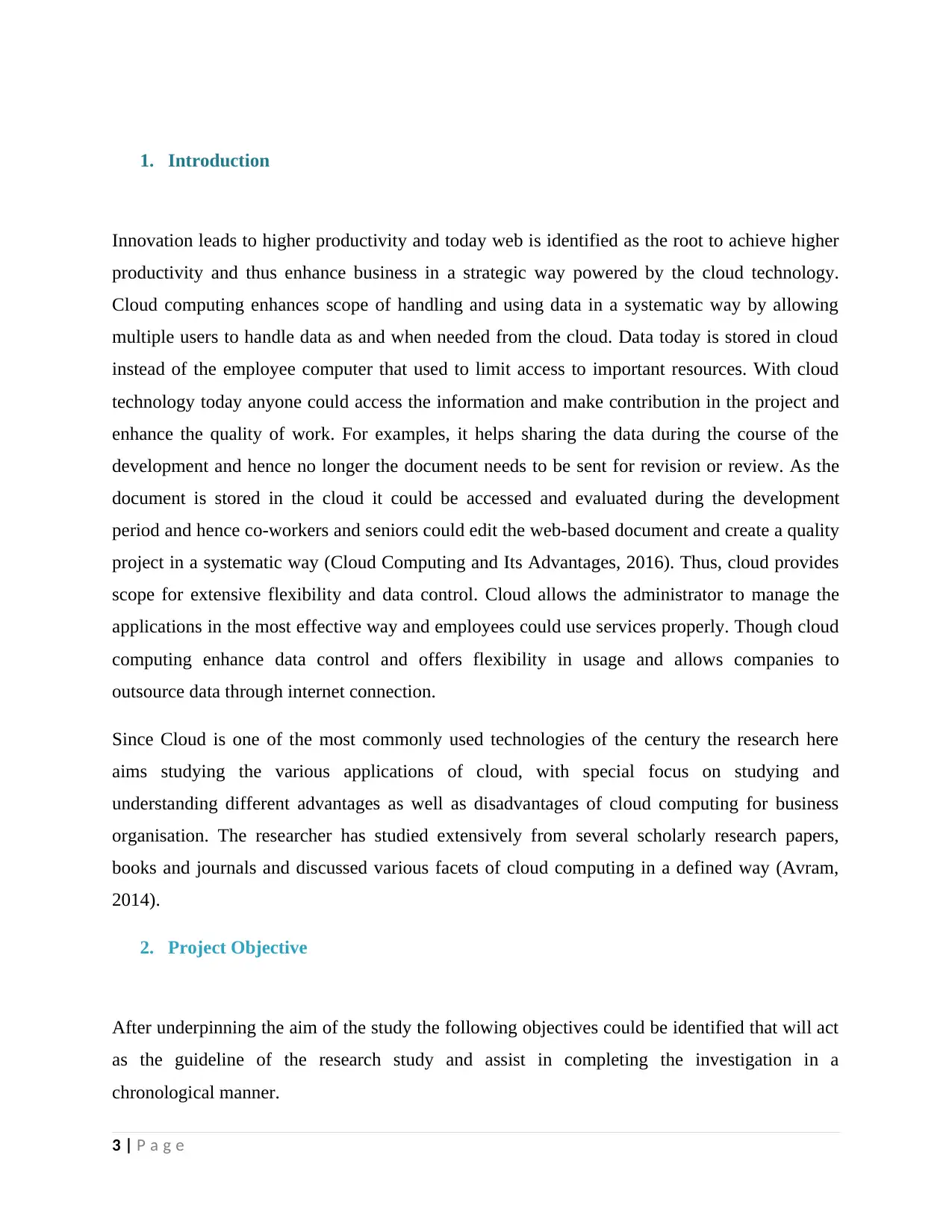
1. Introduction
Innovation leads to higher productivity and today web is identified as the root to achieve higher
productivity and thus enhance business in a strategic way powered by the cloud technology.
Cloud computing enhances scope of handling and using data in a systematic way by allowing
multiple users to handle data as and when needed from the cloud. Data today is stored in cloud
instead of the employee computer that used to limit access to important resources. With cloud
technology today anyone could access the information and make contribution in the project and
enhance the quality of work. For examples, it helps sharing the data during the course of the
development and hence no longer the document needs to be sent for revision or review. As the
document is stored in the cloud it could be accessed and evaluated during the development
period and hence co-workers and seniors could edit the web-based document and create a quality
project in a systematic way (Cloud Computing and Its Advantages, 2016). Thus, cloud provides
scope for extensive flexibility and data control. Cloud allows the administrator to manage the
applications in the most effective way and employees could use services properly. Though cloud
computing enhance data control and offers flexibility in usage and allows companies to
outsource data through internet connection.
Since Cloud is one of the most commonly used technologies of the century the research here
aims studying the various applications of cloud, with special focus on studying and
understanding different advantages as well as disadvantages of cloud computing for business
organisation. The researcher has studied extensively from several scholarly research papers,
books and journals and discussed various facets of cloud computing in a defined way (Avram,
2014).
2. Project Objective
After underpinning the aim of the study the following objectives could be identified that will act
as the guideline of the research study and assist in completing the investigation in a
chronological manner.
3 | P a g e
Innovation leads to higher productivity and today web is identified as the root to achieve higher
productivity and thus enhance business in a strategic way powered by the cloud technology.
Cloud computing enhances scope of handling and using data in a systematic way by allowing
multiple users to handle data as and when needed from the cloud. Data today is stored in cloud
instead of the employee computer that used to limit access to important resources. With cloud
technology today anyone could access the information and make contribution in the project and
enhance the quality of work. For examples, it helps sharing the data during the course of the
development and hence no longer the document needs to be sent for revision or review. As the
document is stored in the cloud it could be accessed and evaluated during the development
period and hence co-workers and seniors could edit the web-based document and create a quality
project in a systematic way (Cloud Computing and Its Advantages, 2016). Thus, cloud provides
scope for extensive flexibility and data control. Cloud allows the administrator to manage the
applications in the most effective way and employees could use services properly. Though cloud
computing enhance data control and offers flexibility in usage and allows companies to
outsource data through internet connection.
Since Cloud is one of the most commonly used technologies of the century the research here
aims studying the various applications of cloud, with special focus on studying and
understanding different advantages as well as disadvantages of cloud computing for business
organisation. The researcher has studied extensively from several scholarly research papers,
books and journals and discussed various facets of cloud computing in a defined way (Avram,
2014).
2. Project Objective
After underpinning the aim of the study the following objectives could be identified that will act
as the guideline of the research study and assist in completing the investigation in a
chronological manner.
3 | P a g e
⊘ This is a preview!⊘
Do you want full access?
Subscribe today to unlock all pages.

Trusted by 1+ million students worldwide
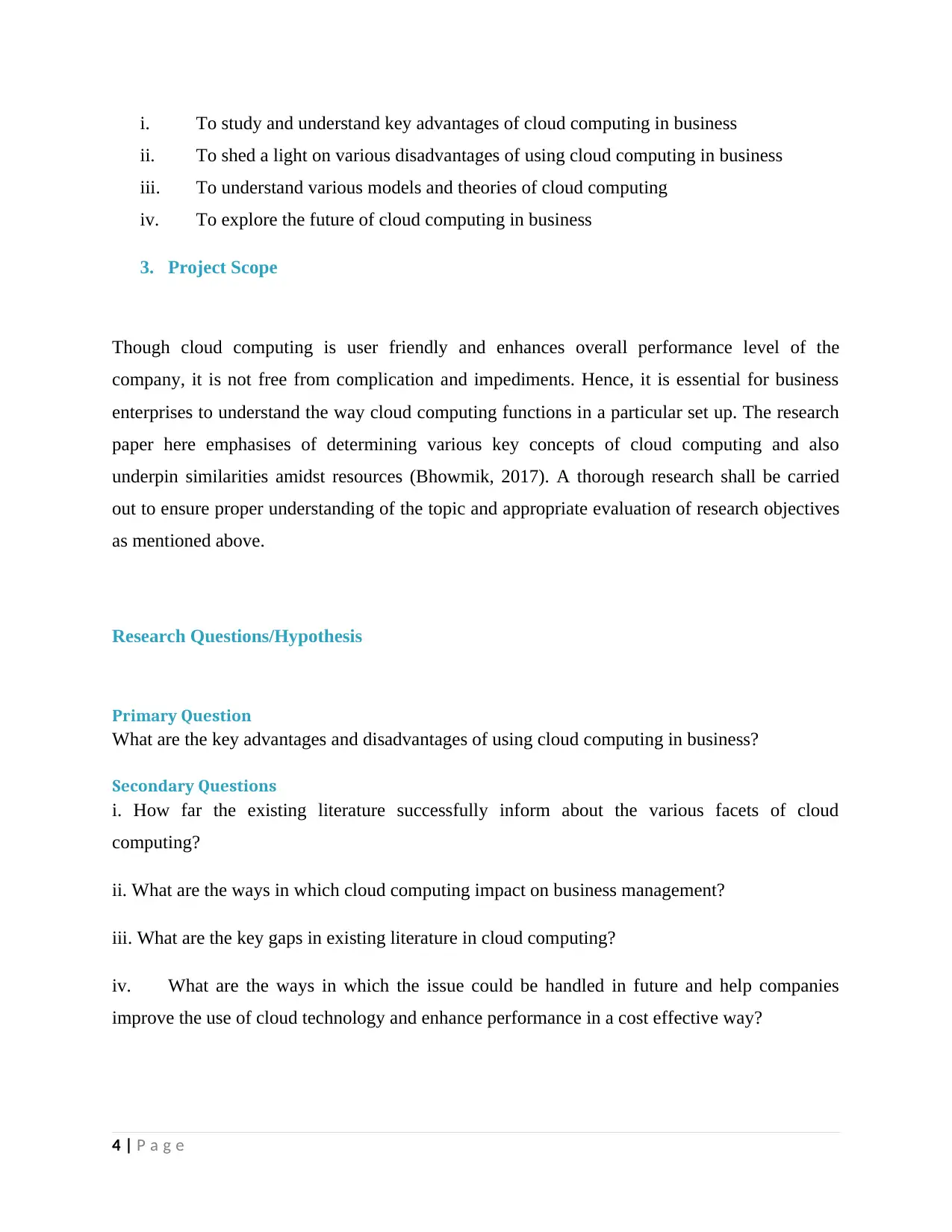
i. To study and understand key advantages of cloud computing in business
ii. To shed a light on various disadvantages of using cloud computing in business
iii. To understand various models and theories of cloud computing
iv. To explore the future of cloud computing in business
3. Project Scope
Though cloud computing is user friendly and enhances overall performance level of the
company, it is not free from complication and impediments. Hence, it is essential for business
enterprises to understand the way cloud computing functions in a particular set up. The research
paper here emphasises of determining various key concepts of cloud computing and also
underpin similarities amidst resources (Bhowmik, 2017). A thorough research shall be carried
out to ensure proper understanding of the topic and appropriate evaluation of research objectives
as mentioned above.
Research Questions/Hypothesis
Primary Question
What are the key advantages and disadvantages of using cloud computing in business?
Secondary Questions
i. How far the existing literature successfully inform about the various facets of cloud
computing?
ii. What are the ways in which cloud computing impact on business management?
iii. What are the key gaps in existing literature in cloud computing?
iv. What are the ways in which the issue could be handled in future and help companies
improve the use of cloud technology and enhance performance in a cost effective way?
4 | P a g e
ii. To shed a light on various disadvantages of using cloud computing in business
iii. To understand various models and theories of cloud computing
iv. To explore the future of cloud computing in business
3. Project Scope
Though cloud computing is user friendly and enhances overall performance level of the
company, it is not free from complication and impediments. Hence, it is essential for business
enterprises to understand the way cloud computing functions in a particular set up. The research
paper here emphasises of determining various key concepts of cloud computing and also
underpin similarities amidst resources (Bhowmik, 2017). A thorough research shall be carried
out to ensure proper understanding of the topic and appropriate evaluation of research objectives
as mentioned above.
Research Questions/Hypothesis
Primary Question
What are the key advantages and disadvantages of using cloud computing in business?
Secondary Questions
i. How far the existing literature successfully inform about the various facets of cloud
computing?
ii. What are the ways in which cloud computing impact on business management?
iii. What are the key gaps in existing literature in cloud computing?
iv. What are the ways in which the issue could be handled in future and help companies
improve the use of cloud technology and enhance performance in a cost effective way?
4 | P a g e
Paraphrase This Document
Need a fresh take? Get an instant paraphrase of this document with our AI Paraphraser
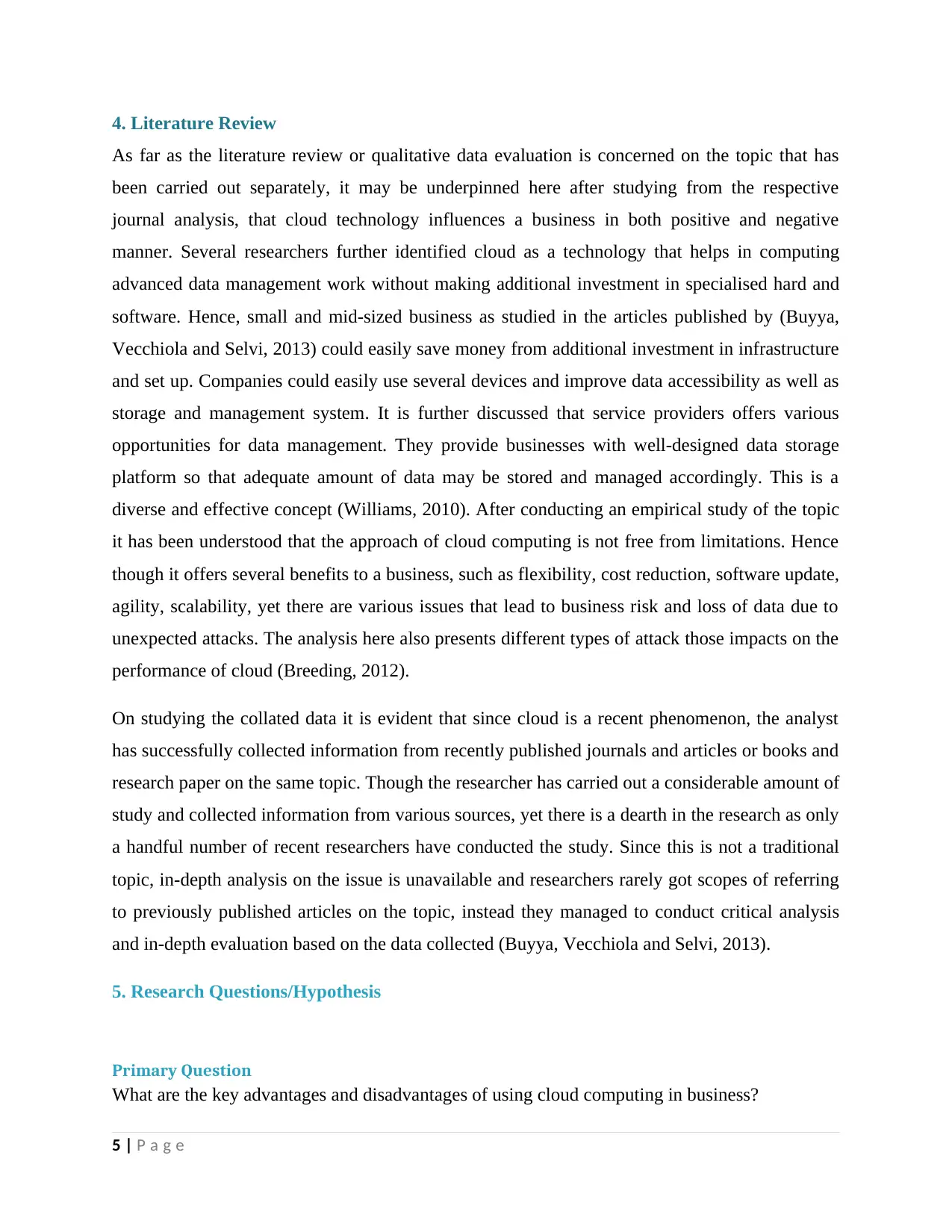
4. Literature Review
As far as the literature review or qualitative data evaluation is concerned on the topic that has
been carried out separately, it may be underpinned here after studying from the respective
journal analysis, that cloud technology influences a business in both positive and negative
manner. Several researchers further identified cloud as a technology that helps in computing
advanced data management work without making additional investment in specialised hard and
software. Hence, small and mid-sized business as studied in the articles published by (Buyya,
Vecchiola and Selvi, 2013) could easily save money from additional investment in infrastructure
and set up. Companies could easily use several devices and improve data accessibility as well as
storage and management system. It is further discussed that service providers offers various
opportunities for data management. They provide businesses with well-designed data storage
platform so that adequate amount of data may be stored and managed accordingly. This is a
diverse and effective concept (Williams, 2010). After conducting an empirical study of the topic
it has been understood that the approach of cloud computing is not free from limitations. Hence
though it offers several benefits to a business, such as flexibility, cost reduction, software update,
agility, scalability, yet there are various issues that lead to business risk and loss of data due to
unexpected attacks. The analysis here also presents different types of attack those impacts on the
performance of cloud (Breeding, 2012).
On studying the collated data it is evident that since cloud is a recent phenomenon, the analyst
has successfully collected information from recently published journals and articles or books and
research paper on the same topic. Though the researcher has carried out a considerable amount of
study and collected information from various sources, yet there is a dearth in the research as only
a handful number of recent researchers have conducted the study. Since this is not a traditional
topic, in-depth analysis on the issue is unavailable and researchers rarely got scopes of referring
to previously published articles on the topic, instead they managed to conduct critical analysis
and in-depth evaluation based on the data collected (Buyya, Vecchiola and Selvi, 2013).
5. Research Questions/Hypothesis
Primary Question
What are the key advantages and disadvantages of using cloud computing in business?
5 | P a g e
As far as the literature review or qualitative data evaluation is concerned on the topic that has
been carried out separately, it may be underpinned here after studying from the respective
journal analysis, that cloud technology influences a business in both positive and negative
manner. Several researchers further identified cloud as a technology that helps in computing
advanced data management work without making additional investment in specialised hard and
software. Hence, small and mid-sized business as studied in the articles published by (Buyya,
Vecchiola and Selvi, 2013) could easily save money from additional investment in infrastructure
and set up. Companies could easily use several devices and improve data accessibility as well as
storage and management system. It is further discussed that service providers offers various
opportunities for data management. They provide businesses with well-designed data storage
platform so that adequate amount of data may be stored and managed accordingly. This is a
diverse and effective concept (Williams, 2010). After conducting an empirical study of the topic
it has been understood that the approach of cloud computing is not free from limitations. Hence
though it offers several benefits to a business, such as flexibility, cost reduction, software update,
agility, scalability, yet there are various issues that lead to business risk and loss of data due to
unexpected attacks. The analysis here also presents different types of attack those impacts on the
performance of cloud (Breeding, 2012).
On studying the collated data it is evident that since cloud is a recent phenomenon, the analyst
has successfully collected information from recently published journals and articles or books and
research paper on the same topic. Though the researcher has carried out a considerable amount of
study and collected information from various sources, yet there is a dearth in the research as only
a handful number of recent researchers have conducted the study. Since this is not a traditional
topic, in-depth analysis on the issue is unavailable and researchers rarely got scopes of referring
to previously published articles on the topic, instead they managed to conduct critical analysis
and in-depth evaluation based on the data collected (Buyya, Vecchiola and Selvi, 2013).
5. Research Questions/Hypothesis
Primary Question
What are the key advantages and disadvantages of using cloud computing in business?
5 | P a g e
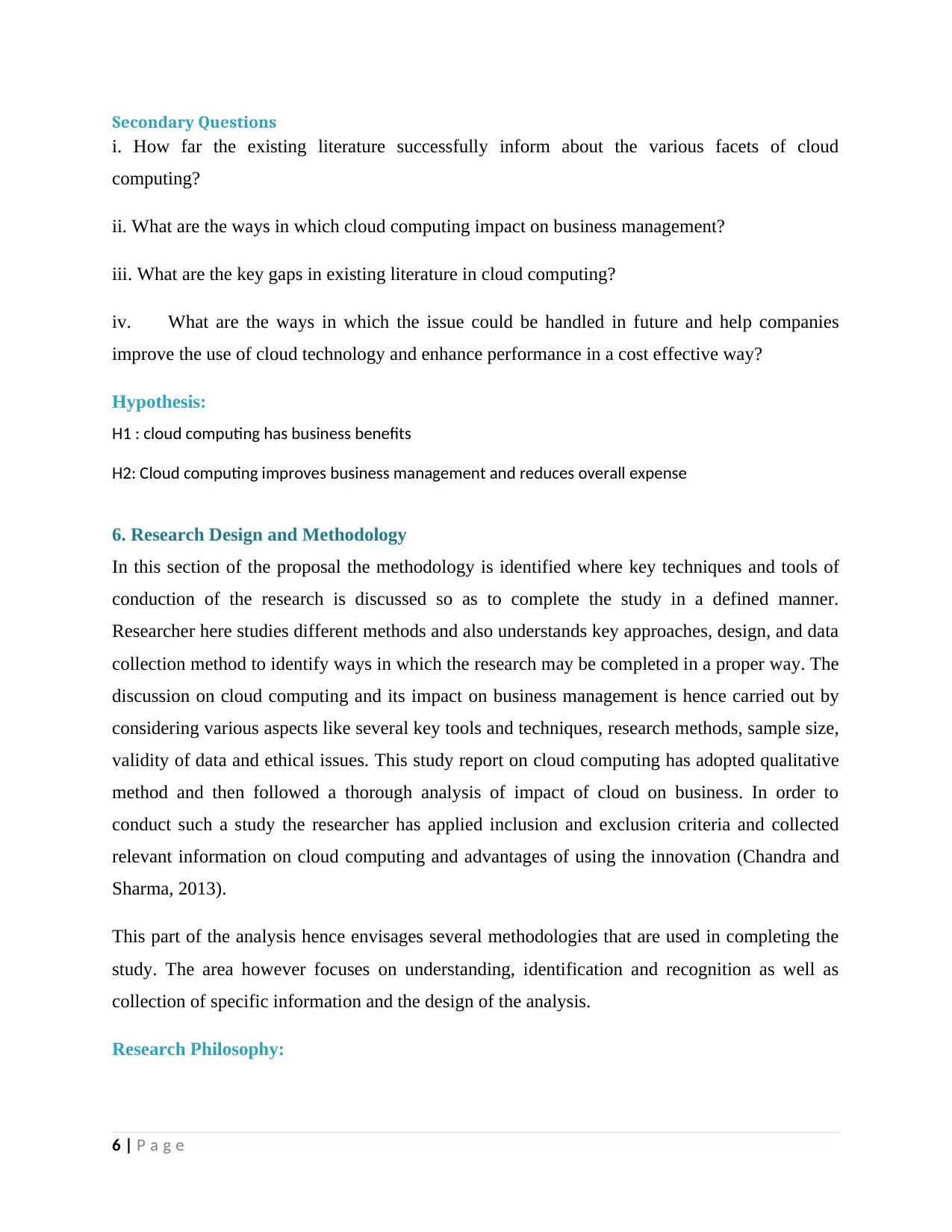
Secondary Questions
i. How far the existing literature successfully inform about the various facets of cloud
computing?
ii. What are the ways in which cloud computing impact on business management?
iii. What are the key gaps in existing literature in cloud computing?
iv. What are the ways in which the issue could be handled in future and help companies
improve the use of cloud technology and enhance performance in a cost effective way?
Hypothesis:
H1 : cloud computing has business benefits
H2: Cloud computing improves business management and reduces overall expense
6. Research Design and Methodology
In this section of the proposal the methodology is identified where key techniques and tools of
conduction of the research is discussed so as to complete the study in a defined manner.
Researcher here studies different methods and also understands key approaches, design, and data
collection method to identify ways in which the research may be completed in a proper way. The
discussion on cloud computing and its impact on business management is hence carried out by
considering various aspects like several key tools and techniques, research methods, sample size,
validity of data and ethical issues. This study report on cloud computing has adopted qualitative
method and then followed a thorough analysis of impact of cloud on business. In order to
conduct such a study the researcher has applied inclusion and exclusion criteria and collected
relevant information on cloud computing and advantages of using the innovation (Chandra and
Sharma, 2013).
This part of the analysis hence envisages several methodologies that are used in completing the
study. The area however focuses on understanding, identification and recognition as well as
collection of specific information and the design of the analysis.
Research Philosophy:
6 | P a g e
i. How far the existing literature successfully inform about the various facets of cloud
computing?
ii. What are the ways in which cloud computing impact on business management?
iii. What are the key gaps in existing literature in cloud computing?
iv. What are the ways in which the issue could be handled in future and help companies
improve the use of cloud technology and enhance performance in a cost effective way?
Hypothesis:
H1 : cloud computing has business benefits
H2: Cloud computing improves business management and reduces overall expense
6. Research Design and Methodology
In this section of the proposal the methodology is identified where key techniques and tools of
conduction of the research is discussed so as to complete the study in a defined manner.
Researcher here studies different methods and also understands key approaches, design, and data
collection method to identify ways in which the research may be completed in a proper way. The
discussion on cloud computing and its impact on business management is hence carried out by
considering various aspects like several key tools and techniques, research methods, sample size,
validity of data and ethical issues. This study report on cloud computing has adopted qualitative
method and then followed a thorough analysis of impact of cloud on business. In order to
conduct such a study the researcher has applied inclusion and exclusion criteria and collected
relevant information on cloud computing and advantages of using the innovation (Chandra and
Sharma, 2013).
This part of the analysis hence envisages several methodologies that are used in completing the
study. The area however focuses on understanding, identification and recognition as well as
collection of specific information and the design of the analysis.
Research Philosophy:
6 | P a g e
⊘ This is a preview!⊘
Do you want full access?
Subscribe today to unlock all pages.

Trusted by 1+ million students worldwide
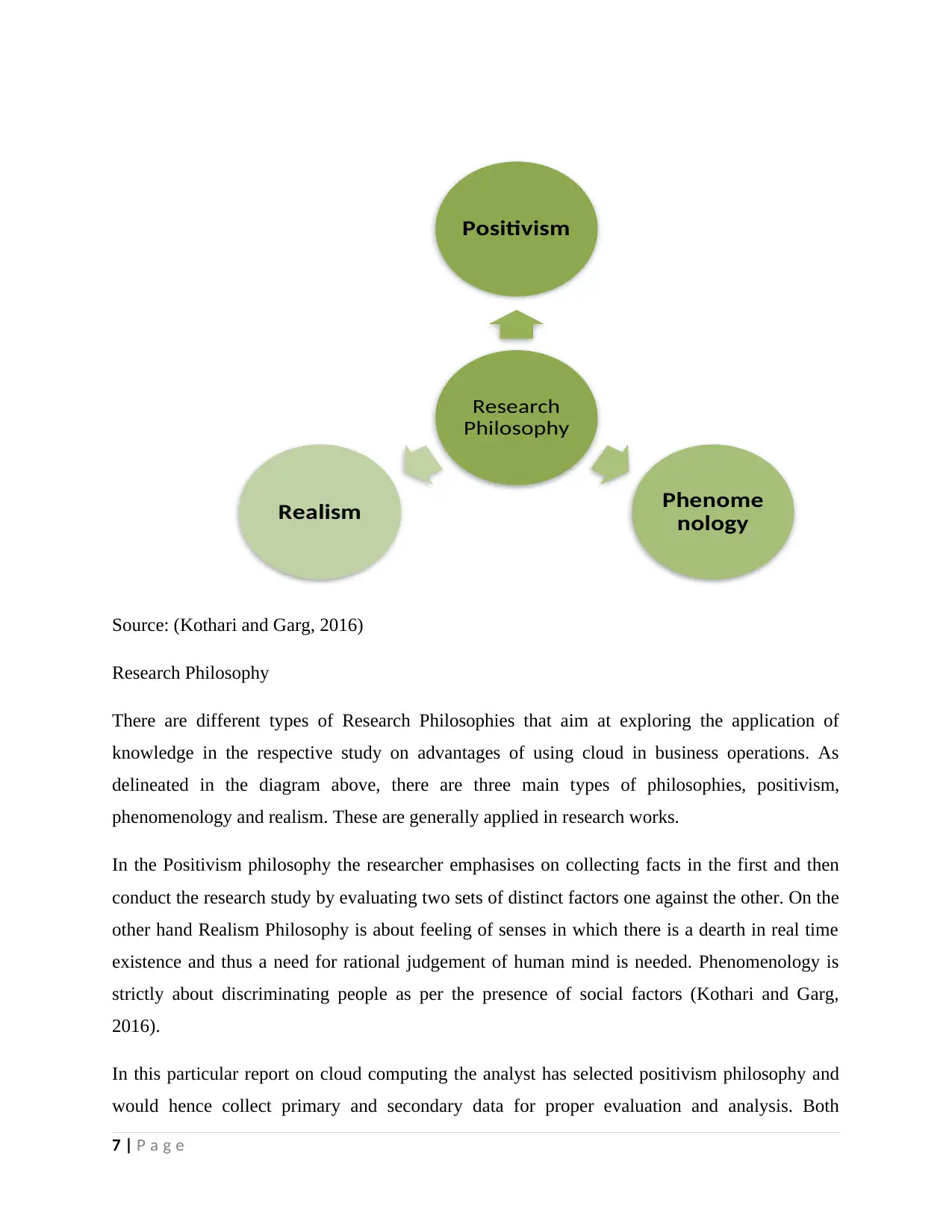
Source: (Kothari and Garg, 2016)
Research Philosophy
There are different types of Research Philosophies that aim at exploring the application of
knowledge in the respective study on advantages of using cloud in business operations. As
delineated in the diagram above, there are three main types of philosophies, positivism,
phenomenology and realism. These are generally applied in research works.
In the Positivism philosophy the researcher emphasises on collecting facts in the first and then
conduct the research study by evaluating two sets of distinct factors one against the other. On the
other hand Realism Philosophy is about feeling of senses in which there is a dearth in real time
existence and thus a need for rational judgement of human mind is needed. Phenomenology is
strictly about discriminating people as per the presence of social factors (Kothari and Garg,
2016).
In this particular report on cloud computing the analyst has selected positivism philosophy and
would hence collect primary and secondary data for proper evaluation and analysis. Both
7 | P a g e
Research
Philosophy
Positivism
Phenome
nology
Realism
Research Philosophy
There are different types of Research Philosophies that aim at exploring the application of
knowledge in the respective study on advantages of using cloud in business operations. As
delineated in the diagram above, there are three main types of philosophies, positivism,
phenomenology and realism. These are generally applied in research works.
In the Positivism philosophy the researcher emphasises on collecting facts in the first and then
conduct the research study by evaluating two sets of distinct factors one against the other. On the
other hand Realism Philosophy is about feeling of senses in which there is a dearth in real time
existence and thus a need for rational judgement of human mind is needed. Phenomenology is
strictly about discriminating people as per the presence of social factors (Kothari and Garg,
2016).
In this particular report on cloud computing the analyst has selected positivism philosophy and
would hence collect primary and secondary data for proper evaluation and analysis. Both
7 | P a g e
Research
Philosophy
Positivism
Phenome
nology
Realism
Paraphrase This Document
Need a fresh take? Get an instant paraphrase of this document with our AI Paraphraser
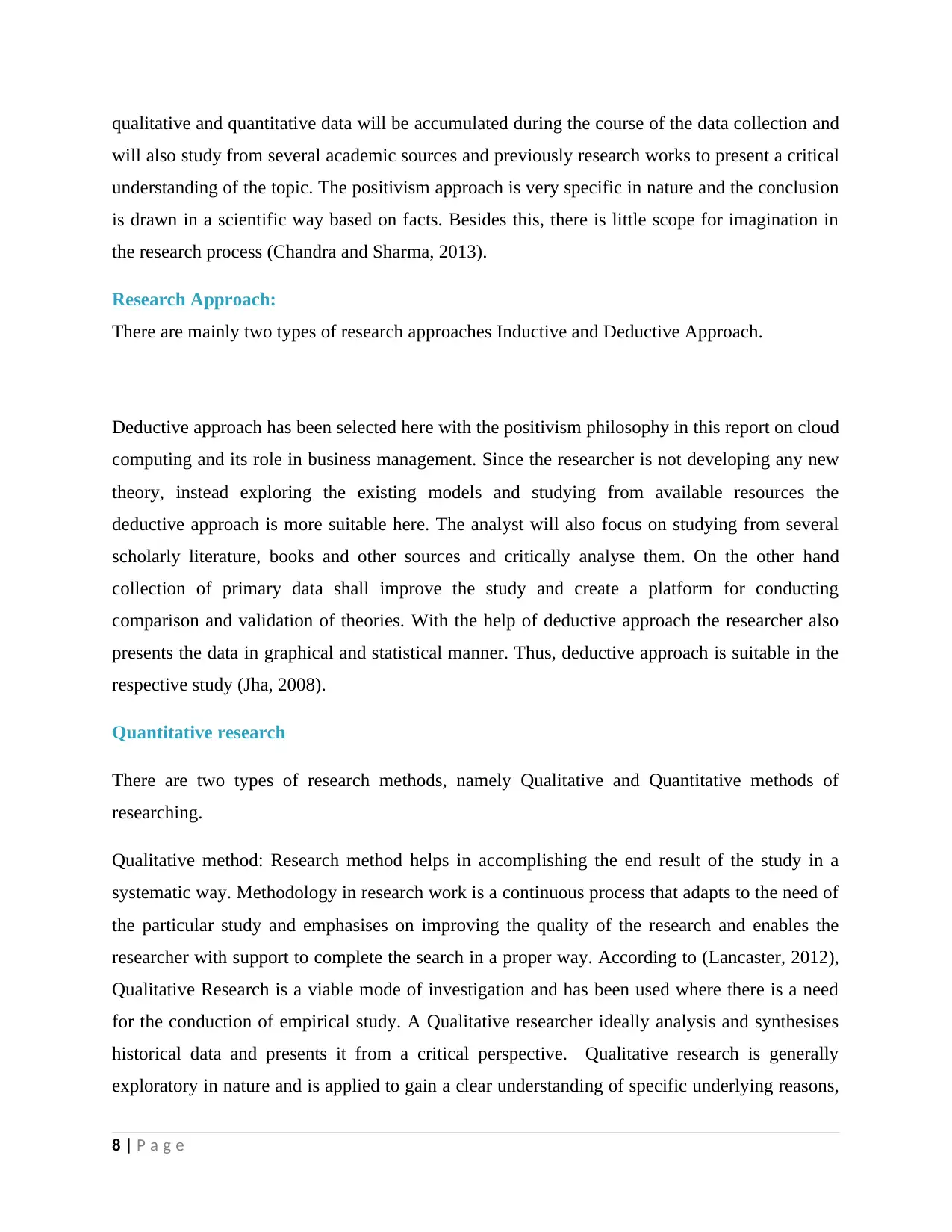
qualitative and quantitative data will be accumulated during the course of the data collection and
will also study from several academic sources and previously research works to present a critical
understanding of the topic. The positivism approach is very specific in nature and the conclusion
is drawn in a scientific way based on facts. Besides this, there is little scope for imagination in
the research process (Chandra and Sharma, 2013).
Research Approach:
There are mainly two types of research approaches Inductive and Deductive Approach.
Deductive approach has been selected here with the positivism philosophy in this report on cloud
computing and its role in business management. Since the researcher is not developing any new
theory, instead exploring the existing models and studying from available resources the
deductive approach is more suitable here. The analyst will also focus on studying from several
scholarly literature, books and other sources and critically analyse them. On the other hand
collection of primary data shall improve the study and create a platform for conducting
comparison and validation of theories. With the help of deductive approach the researcher also
presents the data in graphical and statistical manner. Thus, deductive approach is suitable in the
respective study (Jha, 2008).
Quantitative research
There are two types of research methods, namely Qualitative and Quantitative methods of
researching.
Qualitative method: Research method helps in accomplishing the end result of the study in a
systematic way. Methodology in research work is a continuous process that adapts to the need of
the particular study and emphasises on improving the quality of the research and enables the
researcher with support to complete the search in a proper way. According to (Lancaster, 2012),
Qualitative Research is a viable mode of investigation and has been used where there is a need
for the conduction of empirical study. A Qualitative researcher ideally analysis and synthesises
historical data and presents it from a critical perspective. Qualitative research is generally
exploratory in nature and is applied to gain a clear understanding of specific underlying reasons,
8 | P a g e
will also study from several academic sources and previously research works to present a critical
understanding of the topic. The positivism approach is very specific in nature and the conclusion
is drawn in a scientific way based on facts. Besides this, there is little scope for imagination in
the research process (Chandra and Sharma, 2013).
Research Approach:
There are mainly two types of research approaches Inductive and Deductive Approach.
Deductive approach has been selected here with the positivism philosophy in this report on cloud
computing and its role in business management. Since the researcher is not developing any new
theory, instead exploring the existing models and studying from available resources the
deductive approach is more suitable here. The analyst will also focus on studying from several
scholarly literature, books and other sources and critically analyse them. On the other hand
collection of primary data shall improve the study and create a platform for conducting
comparison and validation of theories. With the help of deductive approach the researcher also
presents the data in graphical and statistical manner. Thus, deductive approach is suitable in the
respective study (Jha, 2008).
Quantitative research
There are two types of research methods, namely Qualitative and Quantitative methods of
researching.
Qualitative method: Research method helps in accomplishing the end result of the study in a
systematic way. Methodology in research work is a continuous process that adapts to the need of
the particular study and emphasises on improving the quality of the research and enables the
researcher with support to complete the search in a proper way. According to (Lancaster, 2012),
Qualitative Research is a viable mode of investigation and has been used where there is a need
for the conduction of empirical study. A Qualitative researcher ideally analysis and synthesises
historical data and presents it from a critical perspective. Qualitative research is generally
exploratory in nature and is applied to gain a clear understanding of specific underlying reasons,
8 | P a g e
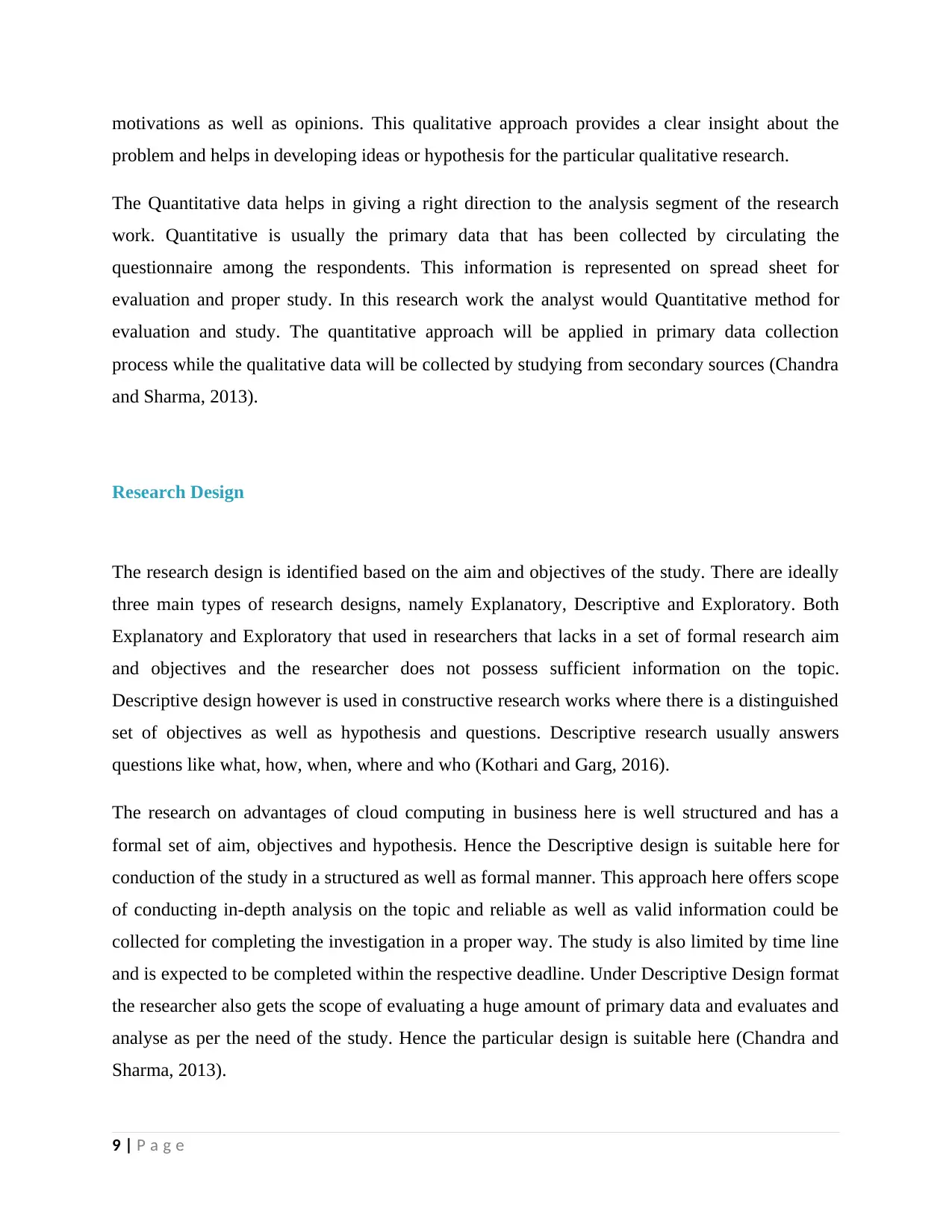
motivations as well as opinions. This qualitative approach provides a clear insight about the
problem and helps in developing ideas or hypothesis for the particular qualitative research.
The Quantitative data helps in giving a right direction to the analysis segment of the research
work. Quantitative is usually the primary data that has been collected by circulating the
questionnaire among the respondents. This information is represented on spread sheet for
evaluation and proper study. In this research work the analyst would Quantitative method for
evaluation and study. The quantitative approach will be applied in primary data collection
process while the qualitative data will be collected by studying from secondary sources (Chandra
and Sharma, 2013).
Research Design
The research design is identified based on the aim and objectives of the study. There are ideally
three main types of research designs, namely Explanatory, Descriptive and Exploratory. Both
Explanatory and Exploratory that used in researchers that lacks in a set of formal research aim
and objectives and the researcher does not possess sufficient information on the topic.
Descriptive design however is used in constructive research works where there is a distinguished
set of objectives as well as hypothesis and questions. Descriptive research usually answers
questions like what, how, when, where and who (Kothari and Garg, 2016).
The research on advantages of cloud computing in business here is well structured and has a
formal set of aim, objectives and hypothesis. Hence the Descriptive design is suitable here for
conduction of the study in a structured as well as formal manner. This approach here offers scope
of conducting in-depth analysis on the topic and reliable as well as valid information could be
collected for completing the investigation in a proper way. The study is also limited by time line
and is expected to be completed within the respective deadline. Under Descriptive Design format
the researcher also gets the scope of evaluating a huge amount of primary data and evaluates and
analyse as per the need of the study. Hence the particular design is suitable here (Chandra and
Sharma, 2013).
9 | P a g e
problem and helps in developing ideas or hypothesis for the particular qualitative research.
The Quantitative data helps in giving a right direction to the analysis segment of the research
work. Quantitative is usually the primary data that has been collected by circulating the
questionnaire among the respondents. This information is represented on spread sheet for
evaluation and proper study. In this research work the analyst would Quantitative method for
evaluation and study. The quantitative approach will be applied in primary data collection
process while the qualitative data will be collected by studying from secondary sources (Chandra
and Sharma, 2013).
Research Design
The research design is identified based on the aim and objectives of the study. There are ideally
three main types of research designs, namely Explanatory, Descriptive and Exploratory. Both
Explanatory and Exploratory that used in researchers that lacks in a set of formal research aim
and objectives and the researcher does not possess sufficient information on the topic.
Descriptive design however is used in constructive research works where there is a distinguished
set of objectives as well as hypothesis and questions. Descriptive research usually answers
questions like what, how, when, where and who (Kothari and Garg, 2016).
The research on advantages of cloud computing in business here is well structured and has a
formal set of aim, objectives and hypothesis. Hence the Descriptive design is suitable here for
conduction of the study in a structured as well as formal manner. This approach here offers scope
of conducting in-depth analysis on the topic and reliable as well as valid information could be
collected for completing the investigation in a proper way. The study is also limited by time line
and is expected to be completed within the respective deadline. Under Descriptive Design format
the researcher also gets the scope of evaluating a huge amount of primary data and evaluates and
analyse as per the need of the study. Hence the particular design is suitable here (Chandra and
Sharma, 2013).
9 | P a g e
⊘ This is a preview!⊘
Do you want full access?
Subscribe today to unlock all pages.

Trusted by 1+ million students worldwide
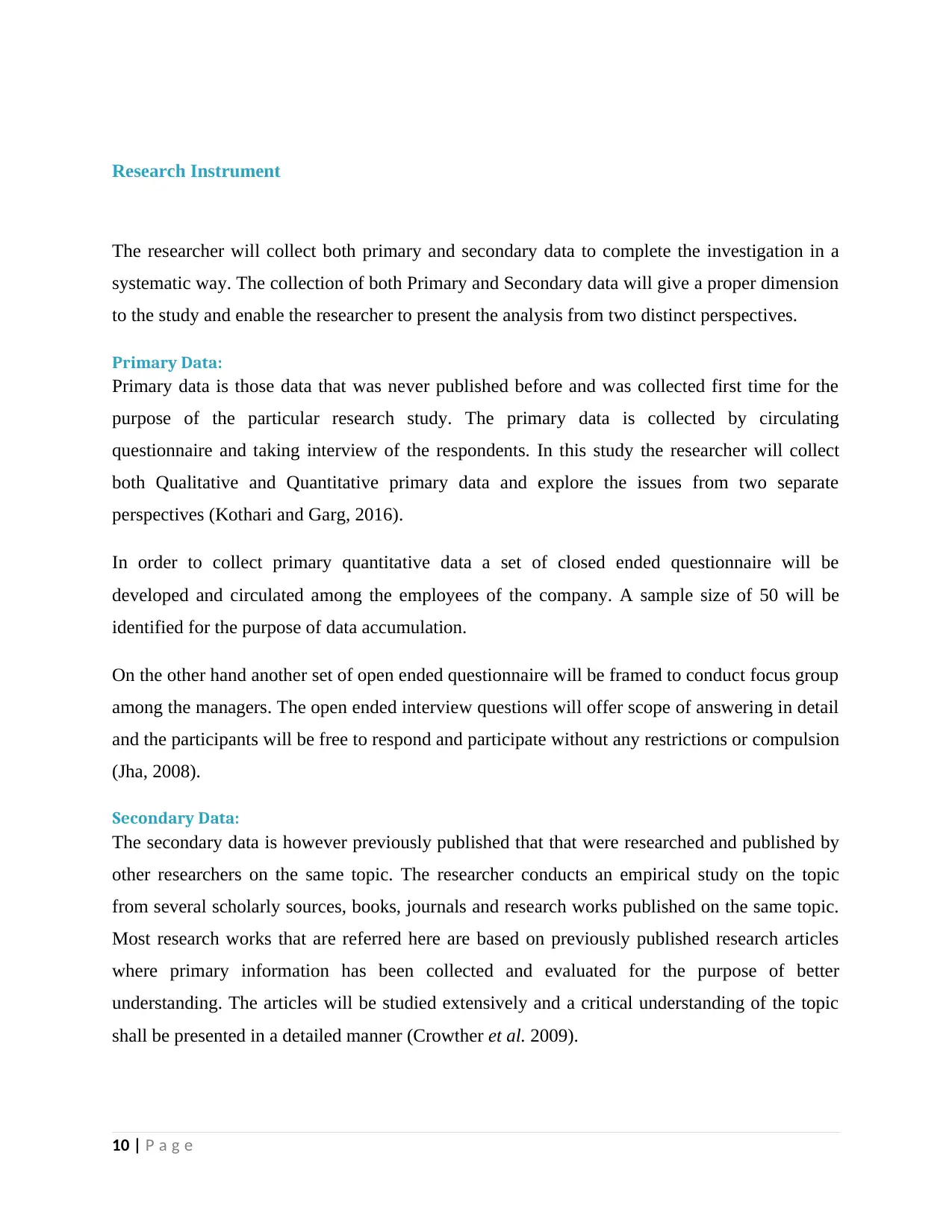
Research Instrument
The researcher will collect both primary and secondary data to complete the investigation in a
systematic way. The collection of both Primary and Secondary data will give a proper dimension
to the study and enable the researcher to present the analysis from two distinct perspectives.
Primary Data:
Primary data is those data that was never published before and was collected first time for the
purpose of the particular research study. The primary data is collected by circulating
questionnaire and taking interview of the respondents. In this study the researcher will collect
both Qualitative and Quantitative primary data and explore the issues from two separate
perspectives (Kothari and Garg, 2016).
In order to collect primary quantitative data a set of closed ended questionnaire will be
developed and circulated among the employees of the company. A sample size of 50 will be
identified for the purpose of data accumulation.
On the other hand another set of open ended questionnaire will be framed to conduct focus group
among the managers. The open ended interview questions will offer scope of answering in detail
and the participants will be free to respond and participate without any restrictions or compulsion
(Jha, 2008).
Secondary Data:
The secondary data is however previously published that that were researched and published by
other researchers on the same topic. The researcher conducts an empirical study on the topic
from several scholarly sources, books, journals and research works published on the same topic.
Most research works that are referred here are based on previously published research articles
where primary information has been collected and evaluated for the purpose of better
understanding. The articles will be studied extensively and a critical understanding of the topic
shall be presented in a detailed manner (Crowther et al. 2009).
10 | P a g e
The researcher will collect both primary and secondary data to complete the investigation in a
systematic way. The collection of both Primary and Secondary data will give a proper dimension
to the study and enable the researcher to present the analysis from two distinct perspectives.
Primary Data:
Primary data is those data that was never published before and was collected first time for the
purpose of the particular research study. The primary data is collected by circulating
questionnaire and taking interview of the respondents. In this study the researcher will collect
both Qualitative and Quantitative primary data and explore the issues from two separate
perspectives (Kothari and Garg, 2016).
In order to collect primary quantitative data a set of closed ended questionnaire will be
developed and circulated among the employees of the company. A sample size of 50 will be
identified for the purpose of data accumulation.
On the other hand another set of open ended questionnaire will be framed to conduct focus group
among the managers. The open ended interview questions will offer scope of answering in detail
and the participants will be free to respond and participate without any restrictions or compulsion
(Jha, 2008).
Secondary Data:
The secondary data is however previously published that that were researched and published by
other researchers on the same topic. The researcher conducts an empirical study on the topic
from several scholarly sources, books, journals and research works published on the same topic.
Most research works that are referred here are based on previously published research articles
where primary information has been collected and evaluated for the purpose of better
understanding. The articles will be studied extensively and a critical understanding of the topic
shall be presented in a detailed manner (Crowther et al. 2009).
10 | P a g e
Paraphrase This Document
Need a fresh take? Get an instant paraphrase of this document with our AI Paraphraser
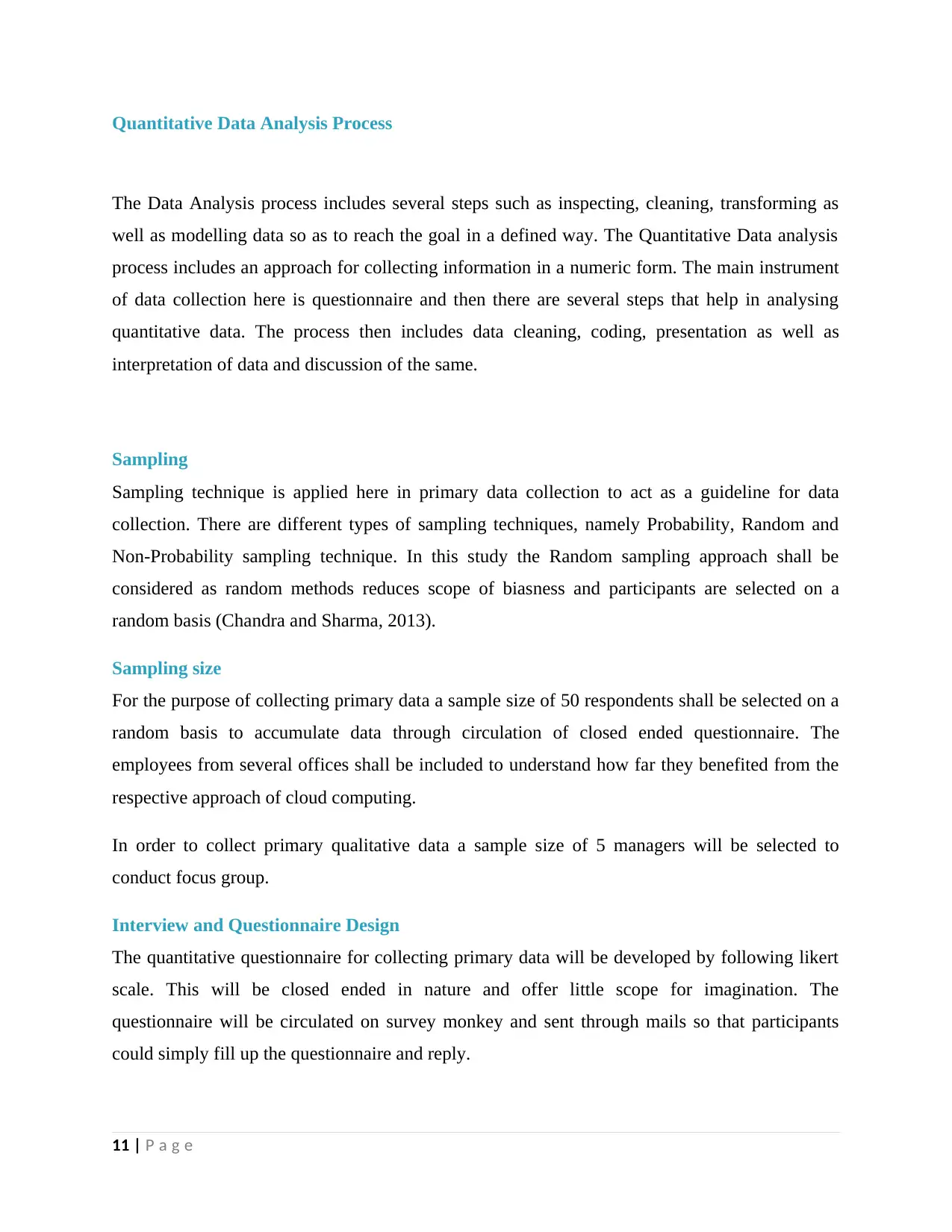
Quantitative Data Analysis Process
The Data Analysis process includes several steps such as inspecting, cleaning, transforming as
well as modelling data so as to reach the goal in a defined way. The Quantitative Data analysis
process includes an approach for collecting information in a numeric form. The main instrument
of data collection here is questionnaire and then there are several steps that help in analysing
quantitative data. The process then includes data cleaning, coding, presentation as well as
interpretation of data and discussion of the same.
Sampling
Sampling technique is applied here in primary data collection to act as a guideline for data
collection. There are different types of sampling techniques, namely Probability, Random and
Non-Probability sampling technique. In this study the Random sampling approach shall be
considered as random methods reduces scope of biasness and participants are selected on a
random basis (Chandra and Sharma, 2013).
Sampling size
For the purpose of collecting primary data a sample size of 50 respondents shall be selected on a
random basis to accumulate data through circulation of closed ended questionnaire. The
employees from several offices shall be included to understand how far they benefited from the
respective approach of cloud computing.
In order to collect primary qualitative data a sample size of 5 managers will be selected to
conduct focus group.
Interview and Questionnaire Design
The quantitative questionnaire for collecting primary data will be developed by following likert
scale. This will be closed ended in nature and offer little scope for imagination. The
questionnaire will be circulated on survey monkey and sent through mails so that participants
could simply fill up the questionnaire and reply.
11 | P a g e
The Data Analysis process includes several steps such as inspecting, cleaning, transforming as
well as modelling data so as to reach the goal in a defined way. The Quantitative Data analysis
process includes an approach for collecting information in a numeric form. The main instrument
of data collection here is questionnaire and then there are several steps that help in analysing
quantitative data. The process then includes data cleaning, coding, presentation as well as
interpretation of data and discussion of the same.
Sampling
Sampling technique is applied here in primary data collection to act as a guideline for data
collection. There are different types of sampling techniques, namely Probability, Random and
Non-Probability sampling technique. In this study the Random sampling approach shall be
considered as random methods reduces scope of biasness and participants are selected on a
random basis (Chandra and Sharma, 2013).
Sampling size
For the purpose of collecting primary data a sample size of 50 respondents shall be selected on a
random basis to accumulate data through circulation of closed ended questionnaire. The
employees from several offices shall be included to understand how far they benefited from the
respective approach of cloud computing.
In order to collect primary qualitative data a sample size of 5 managers will be selected to
conduct focus group.
Interview and Questionnaire Design
The quantitative questionnaire for collecting primary data will be developed by following likert
scale. This will be closed ended in nature and offer little scope for imagination. The
questionnaire will be circulated on survey monkey and sent through mails so that participants
could simply fill up the questionnaire and reply.
11 | P a g e
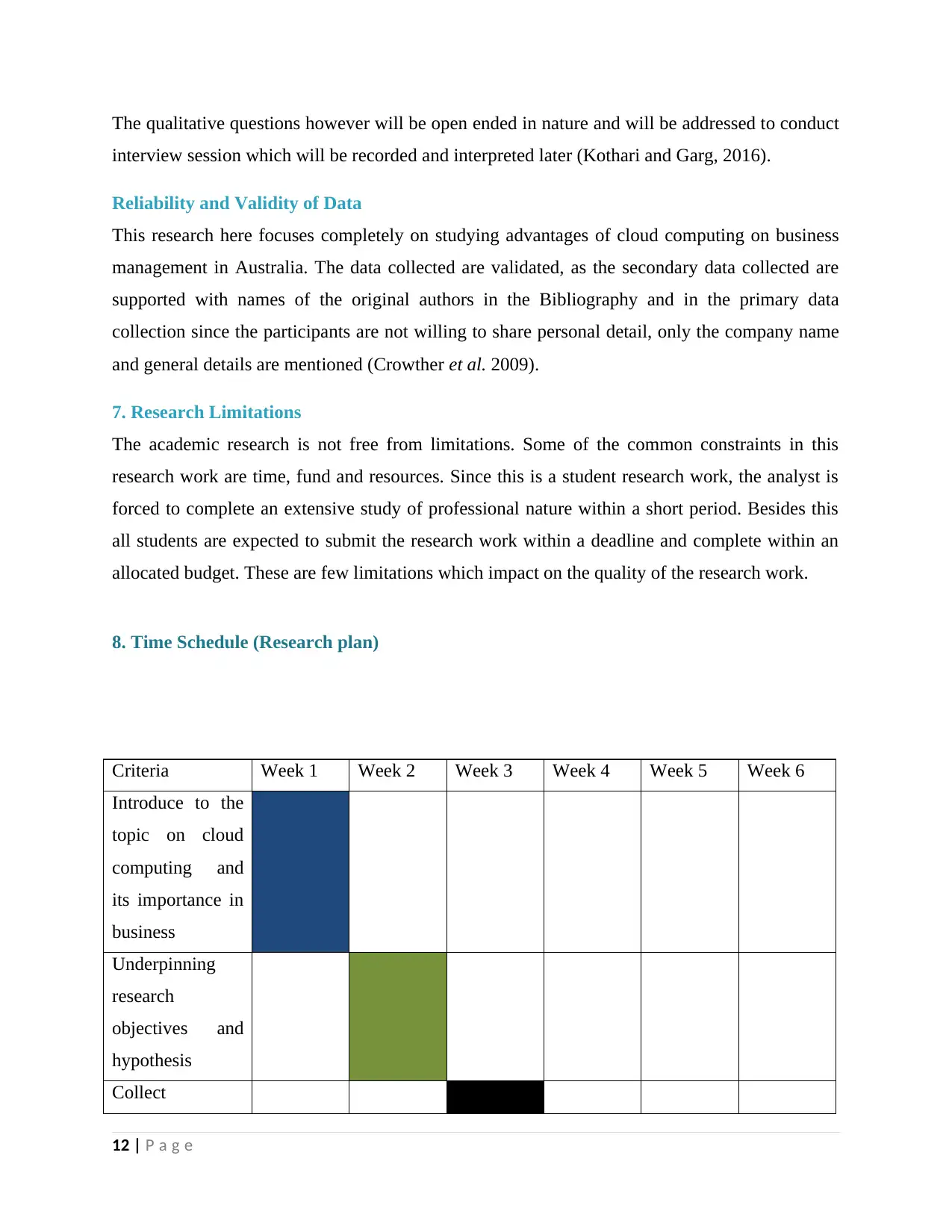
The qualitative questions however will be open ended in nature and will be addressed to conduct
interview session which will be recorded and interpreted later (Kothari and Garg, 2016).
Reliability and Validity of Data
This research here focuses completely on studying advantages of cloud computing on business
management in Australia. The data collected are validated, as the secondary data collected are
supported with names of the original authors in the Bibliography and in the primary data
collection since the participants are not willing to share personal detail, only the company name
and general details are mentioned (Crowther et al. 2009).
7. Research Limitations
The academic research is not free from limitations. Some of the common constraints in this
research work are time, fund and resources. Since this is a student research work, the analyst is
forced to complete an extensive study of professional nature within a short period. Besides this
all students are expected to submit the research work within a deadline and complete within an
allocated budget. These are few limitations which impact on the quality of the research work.
8. Time Schedule (Research plan)
Criteria Week 1 Week 2 Week 3 Week 4 Week 5 Week 6
Introduce to the
topic on cloud
computing and
its importance in
business
Underpinning
research
objectives and
hypothesis
Collect
12 | P a g e
interview session which will be recorded and interpreted later (Kothari and Garg, 2016).
Reliability and Validity of Data
This research here focuses completely on studying advantages of cloud computing on business
management in Australia. The data collected are validated, as the secondary data collected are
supported with names of the original authors in the Bibliography and in the primary data
collection since the participants are not willing to share personal detail, only the company name
and general details are mentioned (Crowther et al. 2009).
7. Research Limitations
The academic research is not free from limitations. Some of the common constraints in this
research work are time, fund and resources. Since this is a student research work, the analyst is
forced to complete an extensive study of professional nature within a short period. Besides this
all students are expected to submit the research work within a deadline and complete within an
allocated budget. These are few limitations which impact on the quality of the research work.
8. Time Schedule (Research plan)
Criteria Week 1 Week 2 Week 3 Week 4 Week 5 Week 6
Introduce to the
topic on cloud
computing and
its importance in
business
Underpinning
research
objectives and
hypothesis
Collect
12 | P a g e
⊘ This is a preview!⊘
Do you want full access?
Subscribe today to unlock all pages.

Trusted by 1+ million students worldwide
1 out of 15
Related Documents
Your All-in-One AI-Powered Toolkit for Academic Success.
+13062052269
info@desklib.com
Available 24*7 on WhatsApp / Email
![[object Object]](/_next/static/media/star-bottom.7253800d.svg)
Unlock your academic potential
Copyright © 2020–2025 A2Z Services. All Rights Reserved. Developed and managed by ZUCOL.





